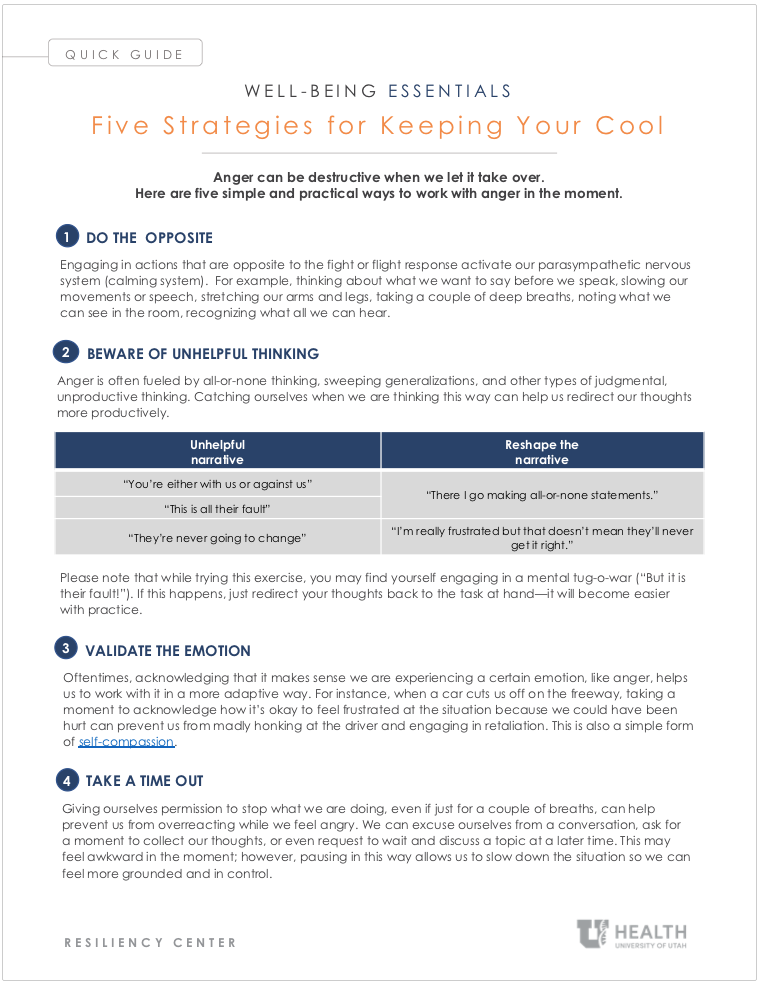nger serves an important function: it shows up when something we care about has been harmed, or has the potential to be harmed. This harm can be either real or perceived. Because of its protective nature, anger quickly activates our fight or flight response.
Reacting in this way can be very helpful, like yelling “Don’t touch that stove!” at a small child who is curious to know what’s for dinner. However, not every moment when anger appears is threatening—even though it can feel that way.
When we misinterpret anger, we tend to overreact to this emotion. Misinterpreting anger can lead to incivility in the workplace, like snapping at or yelling at others.
Setting aside time to understand what causes us to feel angry and how we react to it will help us determine how we want to better work with this emotion when it appears.
“Name it to tame it”
When we label or name the emotion—“I feel angry” or “I feel frustrated”—we begin to reduce the feeling’s grip on us. It’s almost like we’re pressing on a set of mental brakes. Acknowledging that anger is showing up decreases the activity in our amygdala and limbic system, the alarm system in our brain, and simultaneously stimulates part of our prefrontal cortex, the region of the brain that facilitates reasoning and problem-solving. We start slowing down instead of speeding up, which gives us more control over what we do next. So even though it might not feel like labeling is making much of a difference at the time, being present with the emotion in this way is a great first step.
Find the source
Recognizing the source of our anger can prevent us from taking out the anger on an undeserving coworker, family member, or friend. This can be accomplished by reflecting on questions like, “What is this really about?” or “What is this in the service of?” The answer may be something as simple as being hungry, exhausted, or feeling unappreciated or lonely. Often, the actual source of our anger is not what we originally thought. This realization can be both surprising and enlightening. Anger usually appears when expectations, especially unacknowledged ones, haven’t been met or we feel stuck and helpless about a situation.
It is important to acknowledge that we may not always be able to identify the source of our anger and that is okay. Continuously searching for an unknown source may increase rumination and worsen feelings of anger. Instead, during these moments, we can follow the sage advice of Dr. Sylvia Boorstein, a psychologist and expert in mindfulness meditation, and apply a variation of what she tells herself, “Sweetheart, you are in pain. Relax, take a breath and we’ll figure out what to do next.”
Strategies to regain control of your anger
Here are five simple and practical ways to work with anger in the moment. Please note that these tips may not cause your anger to go away immediately but they will help you feel more in control as well as behave like the person you want to be while feeling angry.
1. Do the opposite
Anger causes us to either speed up or completely shut down. We can become tense and rigid, raise our voice, and only focus on what is immediately in front of us. Engaging in actions that are opposite to the fight or flight response helps us to activate our parasympathetic nervous system, our calming system, which allows us to hold steady and better work with anger.
This could include talking slowly, thinking about what we want to say before we speak, slowing our movements, stretching our arms and legs, taking a couple of deep breaths, noting what we can see in the room, and recognizing what all we can hear.
2. Beware of unhelpful thinking
Anger is often fueled by all-or-none thinking (“You’re either with us or against us”), sweeping generalizations (“This is all their fault), and other types of judgmental, unproductive thinking (“They’re never going to change”). Catching ourselves when we are thinking this way (“There I go making all-or-none statements.”) can help us redirect our thoughts toward something more productive, specific and flexible (“I’m really frustrated this patient isn’t following my recommendations but that doesn’t mean they’ll never get vaccinated.”). Please note that while trying this exercise, you may find yourself engaging in a mental tug-o-war (“But it is their fault!”). If this happens, just redirect your thoughts back to the task at hand and reassure yourself that this will become easier with practice.
3. Validate the emotion
Oftentimes, acknowledging that it makes sense we are experiencing a certain emotion, like anger, helps us to work with it in a more adaptive way. For instance, when a car cuts us off on the freeway, taking a moment to acknowledge how it’s okay to feel frustrated at the situation because we could have been hurt can prevent us from madly honking at the driver and engaging in retaliation. This is also a simple form of self-compassion.
4. Act on values
Values are one-word descriptors that can serve as a compass for how we want to treat ourselves, interact with others and engage with the world. Values are particularly useful during difficult moments, especially when we feel stuck and helpless. We can ask ourselves questions like, “What do I want to stand for right now? or What would it look like to act on the value of patience even though I’m really angry?”
Reminding ourselves that we can act on and return to values, like respect and curiosity, may help us discover that we have more options for action than we initially thought.

5. Take a time out
Giving ourselves permission to stop what we are doing, even if just for a couple of breaths, can help prevent us from overreacting while we feel angry. We can excuse ourselves from a conversation, ask for a moment to collect our thoughts, or even request to wait and discuss a topic at a later time. This may feel awkward in the moment; however, pausing in this way allows us to slow down the situation so we can feel more grounded and in control.
Whatever you do, know that feeling angry is normal and is telling you that something is important. Anger can be destructive when we let it take over but choosing a strategy like one above may help you to work with anger in a more productive and compassionate way.
Prompts to work with patients who exhibit anger
In the clinic setting, sometimes it helps to have a few practiced prompts to manage the moment.
- “Help me understand...” This simple prompt can assist with getting to the root of an issue quickly and directly. Some examples include, “Help me understand, what is the worst thing for you about getting vaccinated?” or “Help me understand, what’s the hardest part about our conversation right now?”
- Point out the lapse in the conversation. Calling out what is happening in a respectful ways allows for an opportunity to clarify and reset. This could sound something like, “I’m starting to notice that we’re not on the same page. Are you noticing this, too?” If the patient agrees, a nice follow-up is, “I wonder if we could spend a moment going over what seems to be happening. I want to make sure that you feel heard and respected.”
- Leave enough time to ask for feedback. Checking out with patients prior to ending the conversation helps to address any misunderstandings or anything else that you might have missed. I typically ask, “How was this today?” at the end of each of my sessions. I follow up with, “Top of mind, what are you taking with you from our time together?”
- If things feel out of control or you're worried about aggression, don't hesitate to call BERT (Behavioral Emergency Response Team). This team is trained in de-escalation and is there to help you.
Megan Call
We’re all managing unprecedented stress and fear. What is “normal” right now? How do I cope? Social worker Jean Whitlock describes how our body protects us and offers some strategies to help.
Caring for our community has been our superpower throughout the pandemic. In this moment, however, our capacity for empathy is being challenged. Chief Wellness Officer Amy Locke shares four strategies to help keep your cool when emotions run high.
Health care workers experience trauma every day in multiple ways, making it difficult to fully recover. Jake Van Epps shares tips for recovering and supporting your colleagues through these adverse events.

